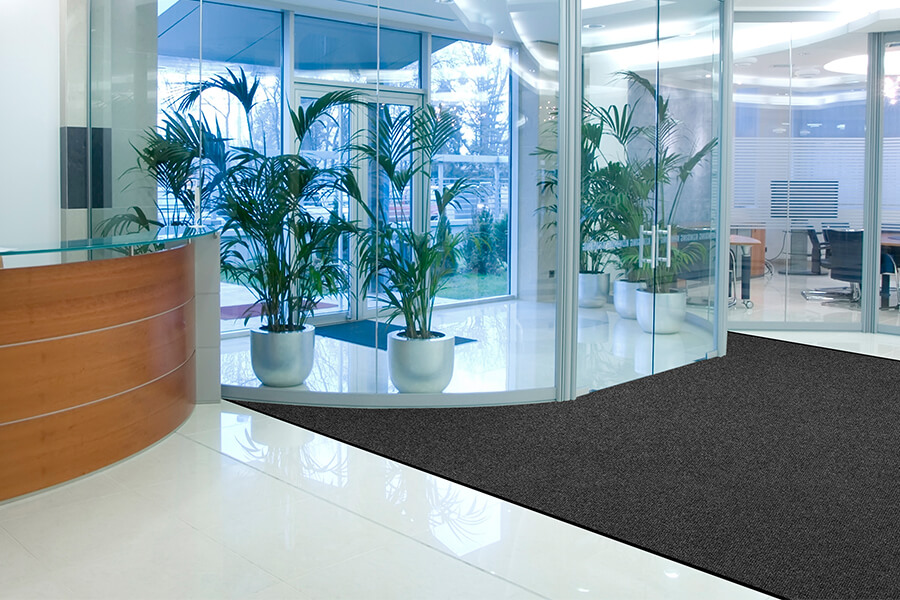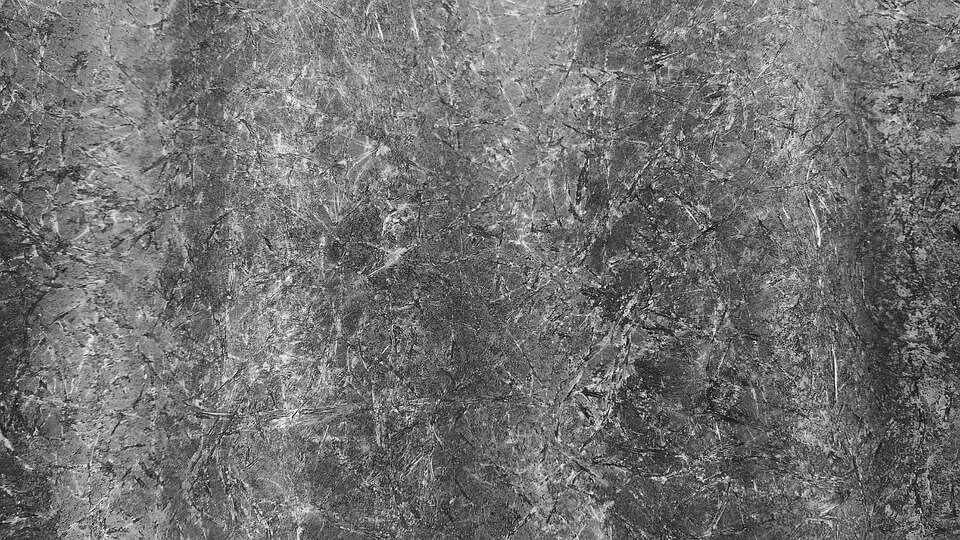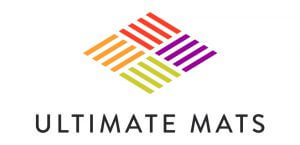
What is the Best Material for Door Mats
Aside from being a welcome invitation to enter an establishment, door mats actually have a really important job. Scraping dirt, debris, and excess moisture from foot traffic entering a home or business, a door mat effectively eliminates potential hazards from making their way to the interior floor space. In fact, 90% of dirt that is tracked into a business comes from the shoes of the patrons that enter upon the premises. Not only do door mats reduce the manpower required to clean a facility, they drastically reduce slip and fall hazards. When you think of door mats in terms of effectiveness, finding a good one takes on an entirely new meaning, and thus, an entirely new set of search parameters. Instead of seeking out a door mat purely for visual appeal, you are now searching for one that will last, do its job effectively, and help eliminate potential safety hazards.
Fortunately, you aren’t left in the dark wondering what’s best and what is subpar. The National Flooring Safety Institute (NFSI) has published standards for proper floor safety and door mat usage. If you think safety hazards aren’t something about which you should worry, you may want to reconsider. Slip and fall accidents account for the vast majority of small business insurance claims, and if you are a business owner considering the installation of door mats on your premises, you need to be familiar with these standards. These regulations govern how mats should be used and maintained, and also outline what can happen when mats are improperly placed or used incorrectly. Even if you are attempting to select a door mat for your personal home use, it is a great idea to become familiar with the availability of matting products so that you can purchase a high-quality mat that lasts longer than its big box store cousins, and can potentially help you avoid claims against your homeowner’s insurance. Ultimate Mats has worked closely within the NFSI’s matting and floor safety guidelines for fifteen years.
We carry a wide selection of door mats that are certified by the NFSI to be skid and slip-resistant. As such, we are particularly familiar with what material constructs a quality door mat, and which materials simply don’t work. We are a team of matting experts that can help you find the right doormat for your home and/or business needs. Following the guidelines of the NFSI’s standards for door mats and floor matting, we’ll look at three things: why door mats are actually needed, the materials with which they should be made, and proper usage of the mats and condition of the underlying flooring. Making sure any door mat adheres to the new floor mat requirements will guarantee that our stores and workplaces are safely outfitted with appropriate matting that will drastically reduce the potential for slip and fall accidents, thereby saving time and money.
Why Do I Need Door Mats?
Not only is a door mat a great way to welcome patrons into your establishment and add to the decor of your business, it’s also a necessary and standard way for you to eliminate potential hazards and keep your floors clean. Here are three reasons why you should be using a door mat:
1. A door mat covers an area of potential risk. Most slip and fall accidents occur near entrance ways and exit ways. This could be due to the amount of dirt and moisture tracked inside a building, or it could be that patrons enter and exit quicker than they linger around inside your shop. Either way, the potential risk for a slip and fall by your front door dictates you should use a door mat. To prevent the most risk, a mat should be placed outside your front door, and directly inside your entrance. Make sure you use a large mat if you have double doors. If the door mat placed outside of your business is a “wiper-scraper” mat, then the interior mat can be simply a “wiper” styled mat. The difference between these two mat styles is the texture and function of the mat surface. A wiper-scraper has tougher, harder tread that effectively wipes and scrapes dirt from the bottoms of shoes. A wiper has a slightly less aggressive tread.
2. Decrease of interior dirt and debris tracking. As mentioned, proper door mats can reduce the amount of dirt entering your building by up to 90%. Even if you are purchasing a door mat for your home, this is significant. From the standpoint of cleanliness, you’ll save yourself and your team a lot of extra time you’d otherwise spend sweeping, vacuuming, and mopping by simply installing proper door mats to catch and trap dirt and debris typically tracked in by foot traffic. This dirt trapping also prevents potential hazards from occurring inside your building. When door mats are not used at the front door of a building or home, the potential for dirt and moisture tracked into the interior space is much higher. Those areas of slick mud or standing water create hazards ripe for slip, trip, and fall accidents.
3. Visual appeal. We would be remiss without stating that the use of beautiful door mats creates a welcoming entrance to any establishment. As a business owner, you’ll make an effective first impression with a high-quality, aesthetically appealing mat that is capable of holding dirt and moisture without looking soiled. As a homeowner, a door mat is virtually standard and creates a hospitable atmosphere that makes a guest feel welcomed, comfortable, and confident they won’t track a mess into your house.
What is the Best Material for Door Mats?

Any manufacturer can produce a door mat. It’s a relatively simple product with an easy construction design. However, there are a lot of considerations that go into making a door mat that’s both aesthetically pleasing and safe. Things like beveled edges, recessed water dams, and high-traction backings all require a level of engineering expertise of which you would not normally think pertains to door mats. As such, here’s some advice when it comes to the materials your mat is made from: Rubber backings. The industry standard backing for door mats is rubber. Nothing tests as well against all flooring styles as rubber. Whether you decide to choose from a recycled rubber backed product or a Nitrile rubber (more resistant to oil and grease than other types of rubbers), your door mat backing should be made from 100% rubber components.
The backing of a door mat is incredibly important. While it should be crafted from rubber, the texture and cleat of a door mat determines how it will grip the surface of your floor and resist skidding. Look for door mats that have been certified as slip-resistant by the NFSI. Mat Surface. While there are different materials from which the surface of a door mat can be constructed, two of the best and most popular for commercial and home matting are polypropylene and nylon. Both of these materials are virtually indestructible, so you can count on them to hold up and resist giving the appearance of being worn for long lengths of time. Your mat surface matters because it must be effective in cleaning shoes without a patron actually having to wipe and/or scrape their feet. In other words, the mat fibers must cling to the shoes of the patron and do the job of wiping and scraping for them. Additionally, the mat surface should have some type of moisture handling system.
A great industry standard door mat is the WaterHog mat, which features a patented water dam barrier that effectively traps water beneath the surface fibers of the mat. Another reason why mat surface matters is due to the actual design placed on the mat. If you have a custom logo mat, for instance, you want to make certain that the fibers of your mat are crush resistant. If not, they can not only look worn in a short period of time, they can actually distort the image (your logo or business name). That’s not an issue you want with door mats, especially a customized door mat that bears your business’s name and logo.
Here’s a more detailed look at popular door mat materials:
To find the right doormat for your needs, you should know about the types of materials used to construct them. Each material has its own advantages, which can include durability, style, and resistance to moisture. An outdoor mat is generally placed outside a front door or patio entrance, while indoor doormats are usually used in entryways or kitchens. Here are some commonly used doormat materials and their key traits to help you choose the best one for your home or business.
PVC Doormats
These mats are made from polyvinyl chloride (PVC). They are highly resistant to water and moisture and easy to clean. PVC-backed mats are durable and can withstand heavy foot traffic, making them suitable for both outdoor and indoor use. They often have a rubber backing that provides a secure grip.
Coir Doormats
Coir mats are made from the fibres of coconut shells and offer an eco-friendly alternative to synthetic materials like PVC. Their rough texture means they can easily remove dirt from muddy shoes. However, they may not withstand constant exposure to wet weather, so they are ideal for covered porches or indoor spaces.
Rubber
Rubber doormats are highly durable and weather-resistant. They don’t absorb water and are perfect for rough outdoor conditions. They can become slippery when wet unless they have a textured surface. Rubber mats can be used indoors, but they lack the aesthetic appeal offered by other materials. They make for some of the best outdoor doormats, however, and can be used year-round.
Polypropylene
Polypropylene is a durable synthetic fiber. It is easy to clean and resistant to mildew and fading. Polypropylene mats dry quickly and can withstand heavy foot traffic, making them a great option for indoor use and as an outdoor doormat.
Nylon
Nylon mats are resistant to wear and tear, stains, and spills. They can withstand heavy foot traffic, making them ideal for high-traffic areas like entryways or hallways. They are also generally easy to clean and maintain, and can trap dirt and absorb moisture.
Vinyl
Vinyl-backed doormats have a solid vinyl backing that covers the underside of the mat. This layer often extends beyond the edges to create a finished border. While they are not as durable as rubber, they have a sleek appearance and are affordable. They can be used as indoor doormats on a wide range of flooring without the risk of staining or reacting with the flooring material.
Proper Usage of Door Mats

You’ve now determined areas of potential hazards and know about door mats that are constructed properly. You may have found the perfect doormat, but if you do not take proper care of them, you could end up causing a bigger problem than the ones you are attempting to remedy. Here are a few tips to ensure you are properly using your door mats: Always make sure the door mats never interfere with the opening and closing of a front door or exit. Having a large mat is essential if you have double doors. If possible, opt for door mats with beveled edges to further reduce the potential risk for tripping. Be sure to use the correct door mats for the job. Certain types of mats should be used outdoors and indoors. Make sure your mat backing grips your flooring.
Door mats can have different backings that make them slip resistant on different types of flooring; for instance some door mats have cleated backings for use on carpeted surfaces. The proper use of door mats not only creates a welcoming look for your business and home, it dramatically reduces the amount of dirt tracked into your establishment and reduces the risk of slip and fall injuries. You should select door mats based on your interior and exterior door mat needs, potential hazards, and amount of foot traffic. Door mats are available in numerous different size, color, and material options, so see for yourself by checking out our wide selection of quality door mats today!
FAQs
What is the most durable material for outdoor door mats?
Rubber is generally considered the most durable material for outdoor doormats. They are waterproof and can handle extreme weather. They are slip-resistant, hold their shape, and can withstand heavy foot traffic in outdoor environments.
Which doormat material absorbs the most water?
Among commonly used doormat materials, nylon doormats are known for being able to absorb and hold water. They can reduce puddles or wet patches by absorbing moisture from shoes, reducing the risk of slips and falls on surfaces like tiles or hardwood floors.
Are coir mats good for rainy weather?
Coir mats are not ideal for rainy weather. While they can absorb moisture, prolonged exposure to rain can cause the fibers to weaken. It’s best to use coir mats in indoor spaces or sheltered or covered areas, like a front porch or patio.
Do rubber mats damage vinyl or wood floors?
Rubber is generally not safe for vinyl floors because it can stain or discolor them by reacting with the chemicals found in vinyl. In most cases, rubber mats will not affect wood flooring. However, certain rubber compounds can react with the finish of some hardwood floors. You should always check if the mat is safe to use on vinyl or wood floors to prevent damage.
What’s the easiest doormat material to clean?
Synthetic doormats made from materials like PVC, polypropylene, and nylon are generally easier to clean compared to natural materials like coir and cotton. Natural and synthetic rubber doormats are also durable and easy to maintain. These materials can often be vacuumed, wiped, and hosed down to remove dirt.
Sources:
https://www.cleanlink.com/hs/article/Matting-That-Reduces-Slips-Trips-And-Falls–15438
https://smallbusiness.findlaw.com/liability-and-insurance/the-small-business-owner-and-slip-and-fall-accidents.html
https://www.cmmonline.com/articles/explaining-the-new-floor-mat-standard
https://www.iccsafe.org/wp-content/uploads/asc_a117/supporting_doc_3-3-1_ANSI_NFSI_B101_6-2012.pdf
4 Comments
Comments are closed.

Best Rug For Sand – brujasdeaskani
[…] While there are different materials from which the surface of a door mat can be constructed, two of the best and most popular for commercial and home matting are polypropylene and nylon. via […]
Living Your Best Life in Your Post-Retirement House - Adult Care Advisors
[…] flowers. And when you’re ready to go back inside, don’t underestimate the value of a good doormat with rubber backing, and a bench nearby for removing shoes to keep dirt and pollen out of your […]
How long does a doormat last? – Whowher.com
[…] https://ultimatemats.com/blog/what-is-the-best-material-for-door-mats […]
Materials for door mat making – Space 4 Improvement
[…] https://ultimatemats.com/blog/what-is-the-best-material-for-door-mats […]